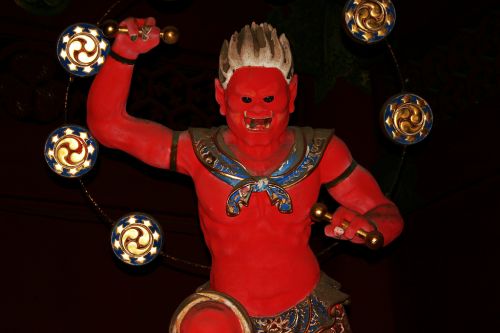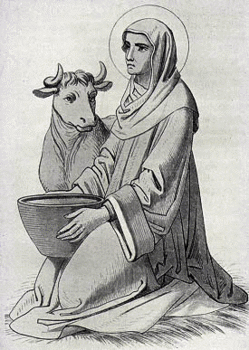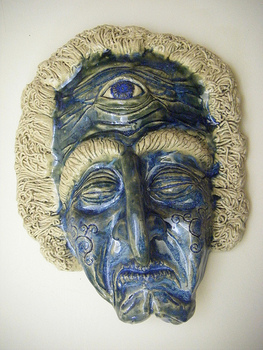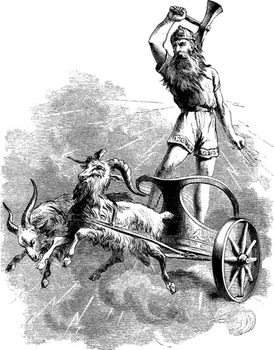Weather Folklore
Weather forecasting has been part of traditions in all civilizations for thousands of years. Farmers wanted the best condition for their crops. Merchants needed favourable weather to sail with their ships full of goods. They looked for the signs in nature. They relied on the experience of previous generations. Mythology and religious beliefs were important factors too. Despite the fact that scientific weather forecasting is used everywhere some of this folk beliefs still exist.
For some people in Kenya Mkunga Mburu is the god of thunder. They believe that he travels across the sky on a huge black bull. Mkunga Mburu holds a spear in each hand. He throws them at clouds to create loud noises. Thunder is created that way.
The Yoruba people used to believe that lightning was actually magic made by the storm spirit. He shoots bolts of light from his mouth. The damage these bolts do on the ground is actually punishment for wrong things people did in their everyday life.
According to Zulu mythology rainbows are snakes which drink from pools of water created after rain. There is more. Those rainbow snakes then continue to live in the water and would eat anyone who bathes there.
In a way similar belief exists in the mythology of the Karen people of Myanmar. For them rainbow is a demon who eats the human soul. Rainbow causes sudden and violent deaths. It is believed that rainbow gets thirsty and appears on the sky. With one its end it finishes on earth where it drinks water.
Chinese people have Mooncakes. They are eaten during Mid-Autumn festival (Zhongqiu Jie). It is a festival of lunar worship and moon watching. The festival includes legends of Chang E, the mythical Moon Goddess of Immortality.
The “Li-Ji” is an ancient Chinese book with information about traditional customs and ceremonies. There it is written that the Chinese Emperor should offer sacrifices to the sun in spring and the moon in autumn. The 15th day of the 8th lunar month is the day called “Mid-Autumn”. In 2012 it is on the 30th of September. In 2013 it will be on the 19th of September.
Ancient Indian mythology includes a belief that the dragon causes periods of drought on Earth Why? Well, actually he prevents the rain from falling. During droughts people prayed to the storm god to draw attention of the dragon and that way allow the rain to fall from clouds.
July can be the time of terrible drought in India. Recently the news appeared in media stating that some people in the Indian state of Bihar use rather strange methods to get more rain. It was reported that in some of local communities single young women worked on fields and chanted hymns naked. This act supposed to force gods to show little mercy and send rain.
Ancient Japanese believed in the existence of the Snow Woman spirit. During snow storms she could make people fall asleep and sometimes cause their death.
 Raijin
Raijin
Raijin is the Japanese god of fire and lightning. It can be seen in many Shinto temples. He is traditionally depicted as red demon surrounded by golden drums which represent thunder. He is a good deity. People believe that he contributes to good crops. That is why the Japanese used to mark the place on rice fields that was struck by lighting with a bamboo stick and a piece of rice straw rope called shimenawa.
People in Turkey thought that the reflection of the Moon in water is actually the Moon fallen on the Earth. Some even tried to capture it.
An Aboriginal myth says that the frost comes from Seven Sisters or the seven stars of the Pleiades. These sisters used to live on the Earth. They were so cold they sparkled with icicles. That is why they decided to live in the sky. Once a year they pull off their icicles and hurl them down to Earth.
The myth about Moon from New Guinea is interesting. Here it goes. Long time ago there was a woman who knew how to make fire. Others want to learn her secret. Even her own children did not know it.
One day two of her kids used an opportunity while she was away to enter the hut. They searched and searched. Suddenly, when they removed the lid of one of pots they saw the Moon. The Moon started to float away. Kids tried to catch it. But it was so slippery. The moon went up to the sky.
For the people of Polynesia rainbow was actually ladders. Local heroes used this ladders to reach the heaven.
Polynesians have a story about the Sun too. Long time ago the sun travelled across the sky very fast. It was quite a problem for the locals as they did not have time to finish their everyday work. The help came from Maui. Maui was half-man, half-God.
He caught the Sun in a huge net he made from the coconut fibre. He threatened the Sun. He said that the Sun should slow its pace when going across the sky or he is going to cut its legs. The Sun became so scared and decided to except Maui's wish. As it can be seen today it is keeping its promise.
Rain can fall for days. It can create lot of problem. How to stop it? In England there is an ancient charm that was recited in hope to stop the rain. Here it is - “Raine, raine, goe to Spain; faire weather come againe”. The charm still exit in little bit changed form - "Rain, rain, go away; come again another day”. Oh yes, the charm has an extra power if you chant it when looking at the rainbow.
Saint Erasmus of Formiae or as it is better known Saint Elmo is the protector of sailors. In the past English sailors used to call the lightning appearing in the rigging of the ship "the body of the saint." Seeing this lighting supposed to be a good omen.
For most of medieval Europeans thunderstorm involved evil spirits. That is why during storm sound of church bells could have been heard in medieval settlements. To protect themselves people used to hide scissors, cover all mirrors, lie on feather beds, and avoid wet dogs and horses.
During pre-christian times in the northern Europe people used to believe that magicians keep winds tied with ropes in their bags. Magicians had special ways to control winds. They have been doing it by changing the tightness of the ropes, the number of knots, and the way the bag was tied.
Long time ago Finns had an interesting way of defining the snow. For them snow was a king. He had three daughters - Thin Snow, Thick Snow, and Snow Storm.
Germans used have rather funny belief about snow. They believed that the snow was actually the feathers shaken off the bed by Old Mother Frost.
In the Greek mythology Iris was wife of the god Zephyrus. It was believed that she created rainbows. Actually, she delivered messages between ordinary mortals and the gods. When performing her duties she wore multicoloured clothes.
The god Aeolus was the one who kept winds trapped in huge cavern. It seems that the strength of wind was much related to the kind of music this god performed. Let's explain. A breeze was a result of him playing his harp. Huge storms were created when he blew his conch shell.
 Saint Brigid of Kildare
Saint Brigid of Kildare
Together with Saint Patrick and Saint Columba, Saint Brigid of Kildare or Brigid of Ireland is one of the patron saints of Ireland. Her feast day is on the 1st February. Traditionally it is the first of Spring in Ireland. It is believed that if this day is dry the spring will be wet.
Josti is the character from Norwegian mythology. He is the son of Kari, the god of winds. It was believed that frost of Earth appeared when he was angry. He then blew it on Earth.
Sirius or the Dog Star is the brightest star on the summer sky. Ancient Romans believed it was the cause of heat in July in August.
 Blue Hag or Cailleach Bheur
Blue Hag or Cailleach Bheur
Scottish mythology includes a creature called the Blue Hag or Cailleach Bheur. She is the bringer of winter. It was believed that she had powers to freeze everything touched. She lived in a cave located in the Scottish highlands. There she kept the Summer Maiden. Blue Hag tried to prevent the arrival of summer.
Folklore in Slovakia includes belief that the twelve bearded men, representing twelve months of the year, are sitting around the fire which is actually the Sun.
 Thor, the god of thunder
Thor, the god of thunder
Long, long time ago, when heard thunder, children were told a story that what they hear is Thor, the god of thunder, riding in his chariot across the sky. And what about the lightning? It also includes the mighty Thor. It's believed that the lightning are sparks from Thor's hammer flying through the air.
For many Bulgarians the hottest days in year are the 15th, 16th and 17th of July. They are called Goreshtnitsi. People believe that on these days one should not work, walk or even make bread. If done otherwise storms or hail can happen and destroy the results of one's work.
The next Bulgarian folk belief takes us to August. The first twelve days of August are known as Makaveyan Days. They named after 12 months of the year. The first day is September, the second one is October etc. People believe that the weather on certain day predicts the weather in certain month of the next year.
The Mordvins (Mordva, Mordvinians) are indigenous people of Russia. As to their folklore people protected their crops from frost by preparing lot of porridge for the Frost Man.
Tsohanoai is the Sun God in traditional Navajo religion. It is believed that each day he travels across the sky with the Sun on his back. During night the Sun rests. It is hung on a peg in the house belonging to Tsohanoai.
The Abenaki or Abnaki people are belonging to the Algonquian American natives. The Abenaki call themselves Alnôbak, meaning "Real People". According to their old belief there is a wind eagle living on top of a mountain. He is creating strong wind by flapping his wings very fast.
Preventing the eagle from making to much wind is the role of mighty Abenaki creature called Gluskabi. Gluskabi climbs the mountain and there he ties the eagle's wings. In the time of big heat Gluskabi returns to the mountain top and untie the eagle.
The Creek American natives believe that in the beginning of the world daily animals used to have magic powers to keep the Sun in the sky. Night animals on the other side tried everything to keep the everlasting darkness.
One day all animals set a meeting to solve the problem. After hours of arguing they found the solution. Seeing the stripped tail of raccoon one animal suggested why do not we split the day equally into time of light and time of darkness.
The Skidi Pawnee, or the Wolf Pawnee are one of the four confederated bands in the Pawnee Nation. Originally they used to live along the Loup River in central Nebraska. Nowadays most of them live in Oklahoma. According to their belief clouds are clothes belonging to gods of heaven. When one of gods spreads his arms, his cloud clothes will be seen across the sky.
The Zuni nation of New Mexico have a legend about a monster called Cloud Eater. This monster is so huge. He just loves to eat clouds. That is why he causes droughts. People tried to find him on many occasions but without success.
The Zuni people also have a lovely saying about predicting rain. It says "If the moon's face is red, of water she speaks".
The Groundhog day is a tradition held by people of Punxsutawney, Pennsylvania. Tradition was brought to the United States by German immigrants. The Groundhog day is organized on the 2nd of February. The key thing on this day is the shadow of groundhog. If he sees his shadow the winter is still very much alive. If he does not see it then people can look forward to fast arrival of spring.
Native people of Peru used to believe that the brightness of stars in the Pleiades constellation in June influences the rainfall in the period from October to May when people raised their crops.